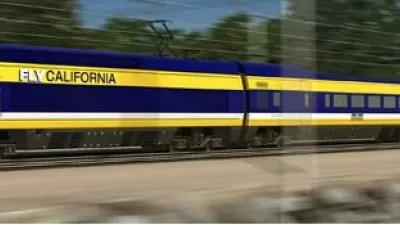The break really isn't that large—only an extra three month before the state must start paying for costs on July 1 (as opposed to April 1) to match federal funding, according to a new state funding contribution plan.
"California bullet train officials have been granted an extra three months to come up with funding to start meeting their obligations under a grant for the project, federal officials said Friday (Feb.21)," writes Ralph Vartabedian.
The additional time would presumably allow the Legislature to act on Gov. Jerry Brown's request for $250 million for the project, allocated from the state's fees on greenhouse gas emissions.
Vartabedian writes that California High-Speed Rail Authority chief Jeff Morales indicated in a Feb. 20 letter to the Federal Railroad Administration that "the funding plan reflects lower expenditure amounts, based on the slower pace of property acquisitions, utility relocations, a later start on construction and the outlook for the construction schedule."
Under its federal grants, the project must match federal money with state money....State officials say in the letter they have spent $95 million of state money against grant disbursements of $255 million.
According to an email from The Fresno Bee's Tim Sheehan, the funding plan, while related to the budget plan, is a different document. Sheehan adds, "So far, the only work taking place is engineering/design; no construction (and the very big bills that will accompany it) yet."
Two additional recent develolpments on the projects to report, one good and one bad for the rail authority.
FULL STORY: Federal authorities give bullet train agency more time to raise cash

Alabama: Trump Terminates Settlements for Black Communities Harmed By Raw Sewage
Trump deemed the landmark civil rights agreement “illegal DEI and environmental justice policy.”

Study: Maui’s Plan to Convert Vacation Rentals to Long-Term Housing Could Cause Nearly $1 Billion Economic Loss
The plan would reduce visitor accommodation by 25% resulting in 1,900 jobs lost.

Why Should We Subsidize Public Transportation?
Many public transit agencies face financial stress due to rising costs, declining fare revenue, and declining subsidies. Transit advocates must provide a strong business case for increasing public transit funding.

Paris Bike Boom Leads to Steep Drop in Air Pollution
The French city’s air quality has improved dramatically in the past 20 years, coinciding with a growth in cycling.

Why Housing Costs More to Build in California Than in Texas
Hard costs like labor and materials combined with ‘soft’ costs such as permitting make building in the San Francisco Bay Area almost three times as costly as in Texas cities.

San Diego County Sees a Rise in Urban Coyotes
San Diego County experiences a rise in urban coyotes, as sightings become prevalent throughout its urban neighbourhoods and surrounding areas.
Urban Design for Planners 1: Software Tools
This six-course series explores essential urban design concepts using open source software and equips planners with the tools they need to participate fully in the urban design process.
Planning for Universal Design
Learn the tools for implementing Universal Design in planning regulations.
Smith Gee Studio
Alamo Area Metropolitan Planning Organization
City of Santa Clarita
Institute for Housing and Urban Development Studies (IHS)
City of Grandview
Harvard GSD Executive Education
Toledo-Lucas County Plan Commissions
Salt Lake City
NYU Wagner Graduate School of Public Service




























